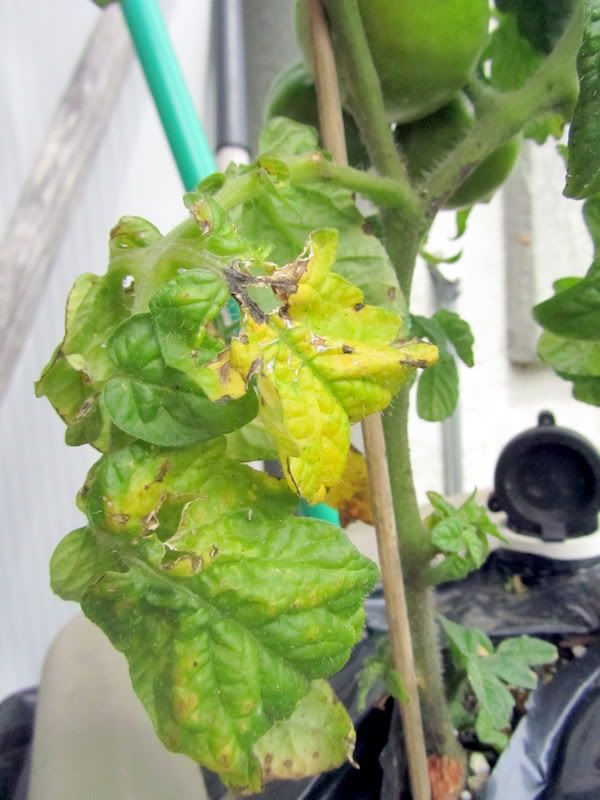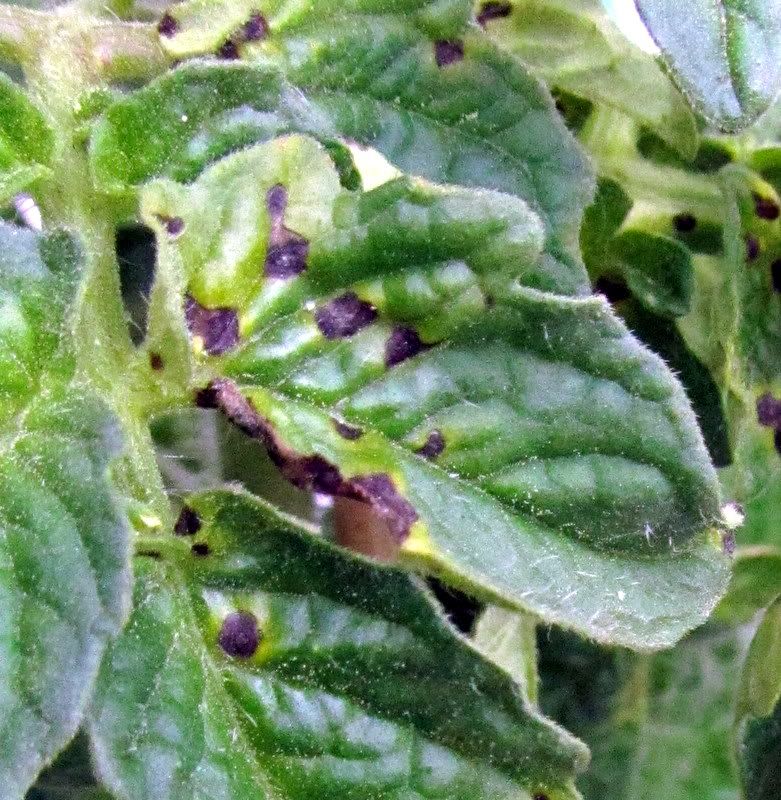

|
Information and discussion regarding garden diseases, insects and other unwelcome critters.
|
 |
|
|
Thread Tools | Display Modes |
|
|
#1 |
|
Tomatovillian™
Join Date: Jul 2011
Location: Northern Indiana
Posts: 3
|
Will appreciate a definite ID of this disease that has shown up on my tomatoes this year - they are Marglobe Improved from Shumways (I started from seed). The disease has appeared in a brand new garden (formerly part of my lawn) where a lot of Miracle Grow Garden Soil was used to prepare - don't know if there is any connection with the use of this soil. I think too late to get it stopped this year as about 1/4 of the leaves on 30 huge plants are affected and a lot of the lower leaves are already brown and dried up. Tomatoes appear to be OK so far and are bearing heavily. Eggplants planted next (and touching) the tomatoes have yellow lower leaves, but are also bearing heavily and seem to be doing fine. Hot peppers planted next and touching the tomatoes appear absolutely unaffected by this disease and also bearing heavily.
Looking towards next year and trying to control it. I hope it is Septoria and not early blight, as I understand that Septoria is not a soil inhabitant and is not so likely to winter over if the plant debris is removed. Man, growing a garden here in Indiana in sandy fill dirt in my development sure seems to be a lot more difficult than it was when I was a kid on an Iowa farm back in the 70's. Any comments on how my plants were likely infected, and how to control? Thanks in advance, Les Myer  
|
|
|

|
|
|
#2 |
|
Tomatovillian™
Join Date: Jan 2006
Location: NY z5
Posts: 1,205
|
Yes, that's Septoria.
There is no special connection with the Miracle-Gro. The disease spores are carried in on the wind, and once in your garden they spread from one leaf to the next on your hands or clothing or by water splashing them into the air. The spores probably traveled on air currents from someone else's infected plants to yours, and yours are now launching spores into the air to infect healthy leaves on your own plants as well as other people's. The spores cannot live in the soil by themselves but they can survive and overwinter on infected plant debris that gets mixed into or left on the soil. Do try to get all the infected leaves into a sealed plastic bag in the trash ASAP and as far away from your garden as possible to help reduce the amount that will be there waiting to infect your tomatoes next year. Healthy foliage can be protected by spraying chlorothalonil or another preventative spray. Try to avoid splashing water on the leaves when watering the plants and be careful about handling healthy leaves after you've touched diseased ones. |
|
|

|
|
|
#3 |
|
Tomatovillian™
Join Date: Jul 2011
Location: Northern Indiana
Posts: 3
|
Thanks very much for the ID and the advice.
Les Myer |
|
|

|
|
|
#4 |
|
Tomatovillian™
Join Date: Mar 2012
Location: hopkinton ma.
Posts: 70
|
where can i find this chlorothalonil. thanks.
|
|
|

|
|
|
#5 |
|
Tomatovillian™
Join Date: Feb 2012
Location: Maryland's Eastern Shore
Posts: 993
|
I was lucky enough to find the concentrate at Southern States this year. I saw the RTU ("Ready To Use") stuff at Lowes. I think I would avoid that unless I just had single plant to care for......
(Yeah, Like That Is Going To Happen!  ) )Pics below will give you a search image.... . . . (Oh... About the gardening being easier when you were a kid in Iowa..... I think all of us who grew up in the 60's and 70's have noticed how everything has gone down hill since we were kids  ) )
__________________
George _____________________________ "The tree of liberty must be refreshed from time to time with the blood of patriots and tyrants. It is it’s natural manure." Thomas Jefferson, 1787 |
|
|

|
|
|
#6 |
|
Tomatovillian™
Join Date: Jul 2011
Location: Northern Indiana
Posts: 3
|
This year gong with Goliath VFFNTASt disease resistant variety and using chlorothalonil. All vegetation completely removed from the garden, but it has been a very warm winter here in northern indiana.
Last year canned 50+ quarts but ugly diseased plants. Marglobe still bore pretty good. |
|
|

|
|
|
#7 |
|
Tomatovillian™
Join Date: Mar 2012
Location: hopkinton ma.
Posts: 70
|
I HAVE GROWN the goliath and still have the leaf spot problem.
|
|
|

|
|
|
#8 |
|
Moderator Emeritus
Join Date: Jan 2006
Location: Upstate NY, zone 4b/5a
Posts: 21,169
|
As was shown in the post below yours in the picture, the common name is Daconil, which is the name given to the active ingredient chlorothalonil.
I prefer the concentrate and say that b'c there are different concentrations of chlorothalonil sold under different brand names. What you want is the one that says about 29.6% active ingredient/ Ortho and Bonide ones I've used and do help. But you need to spray the plants ASAP after putting them out, keep up a regular spray schedule and reapply after rains. Daconil is an anti-fungal, I think the best one around, and is quite effective against the two most common tomato foliage diseases which are Early Blight ( A. solani), which can appear either early OR late in the season, and also Septoria Leaf Spot. No product is 100% effective, so take off any leaves that show signs of either of those two foliage diseases b'c new infections can occur as spread by wind and embedded in rain drops.
__________________
Carolyn |
|
|

|
|
|
#9 | |
|
Tomatovillian™
Join Date: Feb 2012
Location: Maryland's Eastern Shore
Posts: 993
|
Quote:
As I have not used this before but do intend to I have been researching it a bit. Any site I found that bothered to explain the mode of action of Daconil as being a barrier to infection rather than having direct mode of action on the fungi (amazingly that does not include the product itself) agreed with Carolyn 100%, i.e. Use it early and use it regularly. It's a preventative not a cure. I am hoping that this year my plants that start out so beautiful up until initial fruit set, will stay that way much longer.
__________________
George _____________________________ "The tree of liberty must be refreshed from time to time with the blood of patriots and tyrants. It is it’s natural manure." Thomas Jefferson, 1787 |
|
|
|

|
|
|
#10 | |
|
Tomatovillian™
Join Date: Jan 2006
Location: Evansville, IN
Posts: 2,984
|
Quote:
Septoria is horrible, as you can see and have learned from experience. It's particularly bad in the Midwest, and even more so during cooler, damp weather common in late spring (May and June). In Indiana, it usually shows up down in the southern part of the state on advanced transplants setting outside waiting for the mud in your garden to drain enough to poke the plants in the ground. What's worse is when the plants that you thought early on had escaped the ravages of septoria and Early Blight begin to flourish in their cages, along comes cooler June weather cells dumping three days of rain, and voila!, even more septoria. As said above, there really are no resistant varieties, but there are a few that seem to tolerate and outgrow septoria until warmer, drier weather prevails. Septoria is embedded in my tomato garden, but Red Brandywine (Landis) will outgrow it and produce unaffected fruit. So will Big Cheef, Indian Stripe, Not Purple Strawberry, KBX, SpudaYellow Strawberry, and a few others that escape my memory just now. Yes they get spots, but when you trim off the diseased and unnecessary foliage enough to get decent air flow through the canopy, the fruit remains unaffected, and the vine will outgrow the disease. I always have septoria, and rarely use Daconil. The only time I have used it is in an emergency situation when saving certain seeds was absolutely essential. The only variety on which I have never seen a single spot of septoria is Blush; and although I cannot state it is absolutely resistant, both Blush vines grew completely unprunned and directly adjacent to other varieties which were spotted with septoria. Most dwarf varieties I've grown, and I have grown plenty of them, are highly susceptible to septoria. The only dwarf variety I've grown that was able to withstand septoria during really bad years is Red House Free Standing which got the spots but did not go down, and the spots did not get to the fruit, which struck me as odd for a heavily foliaged dwarf. |
|
|
|

|
|
|
#11 |
|
Tomatovillian™
Join Date: Mar 2012
Location: hopkinton ma.
Posts: 70
|
thank you travis. i will try a couple of those varietys.
|
|
|

|
|
|
#12 |
|
Moderator Emeritus
Join Date: Jan 2006
Location: Upstate NY, zone 4b/5a
Posts: 21,169
|
Rebel, regardless of the brand name if it says 29.6% concentrate you're good to go.
__________________
Carolyn |
|
|

|
|
|
#13 |
|
Tomatovillian™
Join Date: Feb 2012
Location: Newfoundland, Canada
Posts: 6,794
|
Like Travis, I find Septoria and also Alternaria (Early Blight) are endemic here - they affect a lot of different plants. My strategy is to help the tomatoes to tough it out.
These diseases always show up first on the lower leaves, unless the whole plant is exposed to rain. I remove the infected leaves, and give the plants a treat of kelp solution and willow water. This seems to work as well for tomatoes outdoors as it does in the greenhouse - although the outdoor tomatoes had more recurrence of Septoria on the lower leaves than the plants protected from (!endless!) rain wetting the leaves. The only tomato plants that got septoria spots all over last year for me, were in a stressed situation outdoors in 4 inch pots without proper care. Once they were transplanted and fed and watered they stopped getting it except on lower leaves. |
|
|

|
|
|
#14 |
|
Tomatovillian™
Join Date: Apr 2007
Location: Campbell, CA
Posts: 4,064
|
My Dwarf Project Iditarod Red planted outside Jan 29 had been doing great. Lots of dark green leaves developing and 5 fruitset. For the past 10 days we've had cool, wet weather. I seem to have developed something similar:
  Carolyn had diagnosed something similar looking as Alternaria on another of my plants last Summer. The fruits all look perfect as of today with no black spots. Any ideas? thanks, Raybo 
|
|
|

|
|
|
#15 | |
|
Tomatovillian™
Join Date: Feb 2012
Location: Newfoundland, Canada
Posts: 6,794
|
Quote:
I'd remove the affected leaves, so it doesn't spread. A dose of willow water (chem equivalent = ASA) did wonders for my plants affected by Alternaria last spring. |
|
|
|

|
 |
| Thread Tools | |
| Display Modes | |
|
|
